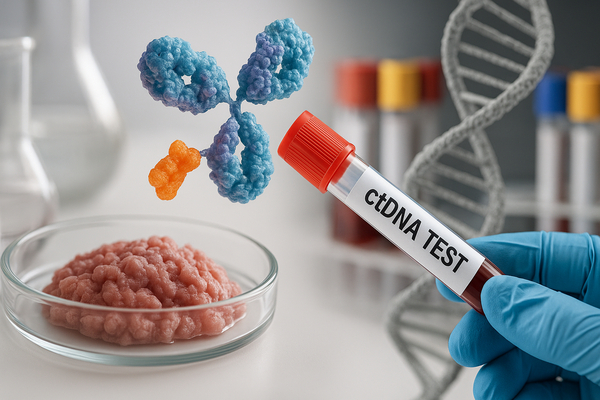
Antibody-drug conjugates and ctDNA tests reshape cancer care now. New trial readouts show ADCs can delay progression and extend survival in aggressive breast cancers, while blood tests cut chemotherapy for low-risk colon patients and help target adjuvant immunotherapy in bladder cancer. Short term, clinical wins lift drug programs and spur dealmaking and regulatory filings across the US, Europe and Asia. Longer term, wider ADC use and routine ctDNA testing suggest changing treatment volumes, pressure on payers, and new commercial paths for oncology firms in developed and emerging markets compared with prior cycles of small molecule and immunotherapy launches.
Clinical momentum for ADCs
Subtitle: New trial wins boost demand for targeted chemo payloads
Antibody-drug conjugates delivered notable efficacy signals at the recent European oncology meeting. Gilead Sciences (NASDAQ:GILD) reported ASCENT-03 results for Trodelvy showing median progression free survival of 9.7 months versus 6.9 months for standard chemotherapy in untreated, locally advanced or inoperable triple negative breast cancer. These results build on earlier findings that Trodelvy adds benefit when patients qualify for immunotherapy.
Daiichi Sankyo (TYO:4568) and collaborators posted results from TROPION-Breast 02 for Datroway. Among 644 patients, median overall survival was about 24 months versus 19 months with standard chemo. Median progression free survival was about 11 months versus 6 months. Separately, preoperative use of Enhertu from Daiichi Sankyo and AstraZeneca (NASDAQ:AZN) improved disease free survival in early stage HER2 positive disease in the DESTINY program.
These readouts accelerate a trend seen over the past few years where ADCs extend targeted therapy beyond HER2 and some solid tumors. Drug developers will likely push ADCs into earlier lines of therapy and broader patient groups. Payers will face questions on pricing and sequencing, while hospital treatment pathways may change if ADCs reduce the need for prolonged infusion chemotherapy.
ctDNA tests move from research to routine decisions
Subtitle: Blood based tumor DNA guides who needs chemo and who may avoid it
Large studies presented at the meeting showed circulating tumor DNA can guide adjuvant treatment intensity. In a trial of over 1,000 stage 3 colon cancer patients, a ctDNA sample taken roughly six weeks after surgery classified patients into low and high risk. Low risk patients, defined by undetectable ctDNA, received less chemotherapy and experienced fewer hospitalizations and nerve damage, while maintaining strong cancer free survival. The study reported 87 percent of low risk patients remained cancer free three years after surgery.
In bladder cancer, an international trial published in The New England Journal of Medicine found ctDNA selection improved outcomes with Roche’s (SIX:ROG) Tecentriq, showing benefits in disease free and overall survival for patients chosen by the blood test. This marks a first for adjuvant immunotherapy trials that use ctDNA to identify those likely to benefit.
The clinical adoption of ctDNA could reduce overtreatment, improve quality of life, and shift chemotherapy demand. Diagnostic companies and payers will need to agree on testing standards and reimbursement, especially across the US, Europe and Asia where regulatory and coding systems differ.
Corporate moves and regulatory signals
Subtitle: Approvals, deals and program changes reshape pipelines and investor focus
Industry headlines around the meeting underscore how scientific results translate into commercial activity. GlaxoSmithKline (LON:GSK) received US approval for a blood cancer therapy, reinforcing vaccine and oncology strategies across markets. Moderna (NASDAQ:MRNA) halted development of a birth defect vaccine, a reminder that pipeline pivots still occur.
Eli Lilly (NYSE:LLY) granted CIPLA (NSE:CIPLA) rights to sell a weight loss drug under a new brand. Innovent (HKEX:1801) signed a cancer therapy deal with Takeda (TYO:4502). Alkermes (NASDAQ:ALKS) entered sleep medicine with a $2.1 billion deal, and Novavax (NASDAQ:NVAX) moved to trim its US portfolio through $60 million agreements. Alector (NASDAQ:ALEC) shares plunged after a dementia candidate failed to slow disease.
Other developments include new funding rounds and program launches from private biotechs, and executive changes such as the Optum unit CFO stepping down at UnitedHealth (NYSE:UNH). Quarterly reports from device and life sciences firms including Boston Scientific (NYSE:BSX) and Thermo Fisher (NYSE:TMO) add to a month of earnings that help investors weigh exposure to medical innovation versus near term reimbursement and cost pressures.
Market implications for patients, payers and investors
Subtitle: Short term volatility, long term reallocation of care and costs
Short term, positive trial data and approvals can lift stock prices for developers and prompt deal activity. They can also intensify competition for scarce trial slots and regulatory bandwidth. Insurers will watch utilization closely while patients may benefit from less toxic regimens and more personalized treatment plans.
Longer term, routine use of ADCs and ctDNA testing suggests a reallocation of oncology spending. Targeted ADC therapy could increase drug spend per patient while reducing hospital resource use. ctDNA guided care could lower chemotherapy exposure, reduce adverse events and concentrate high cost treatments on those most likely to benefit. These trends will play out differently in the US, where private insurers and Medicare set payment rules, in Europe, where national health systems control adoption, and in Asia and emerging markets, where access and pricing remain central challenges.
Health care affordability remains a backdrop. Annual premiums for US families with employer sponsored coverage rose about 6 percent to nearly $27,000 in 2025. That rise will influence payer negotiating positions as new oncology tests and drugs seek reimbursement.
Overall, the recent data and industry moves point to a more stratified oncology market. Clinical benefit will drive regulatory decisions and commercial strategies, while payers, providers and patients will need to adapt to faster adoption of targeted chemotherapies and precision diagnostics. This update is informational and does not constitute financial advice.












